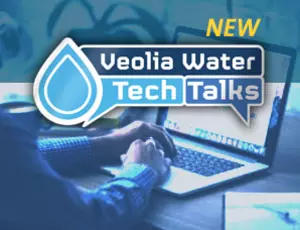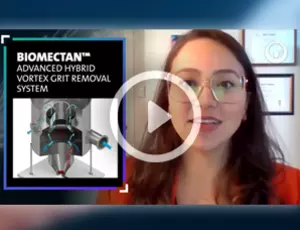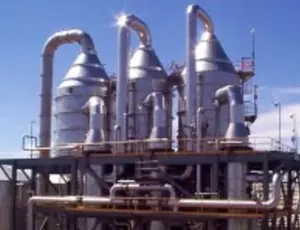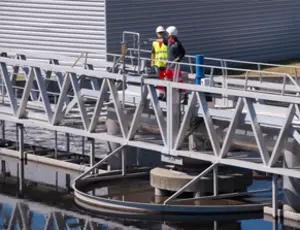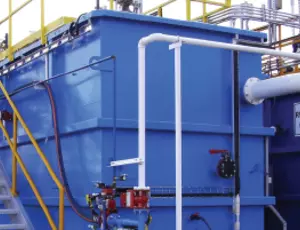Freshwater scarcity and concerns for environmental impact resulting from industrial wastewater discharges place a high degree of importance on recycling and reuse of water, an increasingly valuable resource.
As stricter regulations, environmental sensitivity, and long-term water supply concerns increase, many industrial companies are reducing their operating water discharges with Zero Liquid Discharge technology.
Veolia is the ZLD plant supplier of choice for many industrial clients. Veolia has decades of innovation using wastewater evaporation by zero discharge technology in many wastewater treatment applications including industry experience in volume reduction and ZLD solutions:
- Power Generation (fossil and nuclear fuel)
- Oil & Gas field produced water (conventional and unconventional)
- Oil & Gas Refining
- Chemical Processing and Manufacture
- SAGD (Steam Assisted Gravity Drainage, EOR)
- Mining and Ore Processing
- Industrial and Municipal Landfill
Veolia has the expertise to design and build wastewater reduction and ZLD solutions of any size, for various industries, anywhere in the world. Delivery of a project on a lump-sum, turnkey basis ensures that customers have a single point of responsibility. Veolia also specializes in the operation and maintenance of a zero discharge wastewater treatment system for a fixed term.
Process Experience for a Variety of Effluent Streams
Each effluent stream presents its own unique challenge when designing an entire ZLD plant process to efficiently and effectively minimize waste or eliminate the discharge of wastewater in the environment by using ZLD solutions.
In order to clean water in industrial sectors, a recovery solution needs quality equipment and services. Veolia's approach in the treatment and management of these streams include specification and complete ZLD system design utilizing water treatment expertise from Veolia Water Technologies such as ZLD desalination, deoiling, softening, clarification, and filtration for the following processes:
- Membrane System Reject (NF, MF, UF, RO)
- Cooling Tower Blowdown
- Flue Gas Desulfurization (FGD) Blowdown / Purge
- Produced Water (Conventional, Fracking, SAGD)
- Integrated Gasification Combined Cycle (IGCC) Gray Water
- Mine Drainage
- Refinery, Gas to Liquid (GTL), and Coal to Chemical (CTX) Wastewaters
- Scrubber Blowdown
- Demineralization Waste
- Landfill Leachate
Read our article: Proven ZLD Systems Designed to Meet Today’s Demands
Featured Resources & Information
People Also Ask
Why is Zero Liquid Discharge (ZLD) important?
Why is Zero Liquid Discharge (ZLD) important?
Water scarcity and increasing focus of environmental impact from industrial use place a high degree of importance on recycling and reuse of this valuable resource. Sustainability initiatives and regulation, coupled with water conservation efforts worldwide, are putting progressively strict limits on aqueous discharge and reuse standards for wastewater treatment.
Management of the entire water cycle for industrial applications drives efficiency and innovation towards zero liquid discharge (ZLD) in nearly every major industrial application.
What are Zero Liquid Discharge (ZLD) Systems?
What are Zero Liquid Discharge (ZLD) Systems?
ZLD systems are designed to take wastewater through a series of physical, chemical, and thermal technologies that produce two outputs: treated water that can be reused and, concentrated brine, which is further processed to separate salt crystals for disposal or beneficial use.
In broad terms, there are two general ZLD technologies that work to remove dissolved solids and impurities: thermal and membrane processes and frequently a combination of both in a hybrid form. The rapid advance of membrane technologies over the last few decades has been nothing short of remarkable. However, thermal systems based on established, proven technologies are often considered for more robust and versatile solutions to achieve concentrations near saturation or super-saturation in both complete water recovery and near (partial) ZLD which may dispose of evaporator concentrate by injecting it deep underground.
What are some real-life case studies of ZLD?
What are some real-life case studies of ZLD?
Shell Pearl GTL
Industrial City, Qatar
The Pearl project is the world’s largest Gas-to-Liquid (GTL) facility with outputs of GTL products, condensate, liquefied petroleum gas and ethane. Veolia was selected to provide an environmentally sound water treatment complex to treat the effluents with the highest efficiency of water reuse within the plant with no aqueous discharge. HPD Evaporation and Crystallization technologies are the heart of the design for the world’s largest zero liquid discharge system. Waste volumes from the overall process are minimized and the residual effluent stream produces solid residue. The plant will rely on the water recovered from this system as a major portion of the overall makeup demand.
West Phoenix 5 Power Plant
Phoenix, AZ USA
Located in southwest Phoenix, this natural gas-fired, combined-cycle power plant generates nearly 1,000 megawatts of electricity for the
Southwestern United States. Veolia supplied an HPD zero liquid discharge system designed to treat the plant’s effluents and produce high-quality condensate for boiler feed water. A single, 500 gpm falling film evaporator recycles a majority of the water back into the process. This is followed by a 15 gpm brine crystallizer that concentrates the effluent solids to dry cake for landfill disposal.
The plant sends its wastewater, consisting primarily of cooling tower blowdown to a Zero Liquid Discharge wastewater treatment system. As the high-quality “distillate” or recovered water is returned as makeup water for steam generation, and the balance returned to the cooling tower, the dried solids are trucked to a landfill. Thanks to ZLD, the plant maintains optimal operation while minimizing withdrawals and protecting scarce water sources.
Bayswater Power Station
New South Wales, Australia
Bayswater Power Station, a 4 x 660 MW generation facility, is a vital producer of electricity for the people of New South Wales and is located 250 km north of Sydney. Veolia Water Technologies was awarded the project for an overall plant upgrade of the entire water plant including optimization of the existing ZLD system. As part of this project, Veolia provided much-needed process and equipment modifications to the brine concentration system to increase salt removal and treatment capacity. An additional falling film evaporator was integrated into the system to control operating conditions with a resulting improvement in power consumption, increased process efficiency, and extension of current equipment life. A brine crystallizer was also incorporated into the process to remove more water from the waste stream to reduce the overall volume directed to the existing on-site brine decant basin.
When is zero liquid discharge for water treatment critical to implement?
When is zero liquid discharge for water treatment critical to implement?
ZLD technology is critical when the surrounding environment is fragile and cannot withstand even the discharge of treated wastewater effluent. ZLD also offers another major advantage: since no effluent is discharged, water legislation need not be taken into account. Last but not least, it sometimes allows you to avoid post-treatment.



